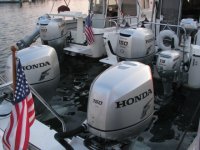Discovery
Active member
- Joined
- Dec 8, 2003
- Messages
- 1,245
- Reaction score
- 0
- C Dory Year
- 2006
- C Dory Model
- 255 Tomcat
- Hull Identification Number
- CDO25510J506
- Vessel Name
- Discovery
I have towed two different TomCats ( 24' and 255 ) for over 50,000 miles. With the TomCat road clearance is not a problem because the boat sits over the wheels. I always position the motors in the full down position.
When I had a CD 22' I also left the motor down, but was much more careful driving through dips into and out of fuel stops and exiting and entering the road.
With our Tracker Targa 17', I have to use a motor support that goes from the lower unit to the trailer frame. This boat sits really low between the wheels and is a modified "V" hull. I position the motor almost all the way up and use the brace. I use two ratchet straps going from the motor to the transom tiedown eyes, on 45 degree angles. The straps attach to the Dolphin tail on the lower unit. I pull the straps tight, and they keep the motor from jumping up and down, or tipping off to one side on rough roads. Motor movement had been a major problem on the Tracker, it's a Merc 90 HP, short shaft. I have towed this boat 1500 miles and back to Texas, four times, without problems.
Brent
When I had a CD 22' I also left the motor down, but was much more careful driving through dips into and out of fuel stops and exiting and entering the road.
With our Tracker Targa 17', I have to use a motor support that goes from the lower unit to the trailer frame. This boat sits really low between the wheels and is a modified "V" hull. I position the motor almost all the way up and use the brace. I use two ratchet straps going from the motor to the transom tiedown eyes, on 45 degree angles. The straps attach to the Dolphin tail on the lower unit. I pull the straps tight, and they keep the motor from jumping up and down, or tipping off to one side on rough roads. Motor movement had been a major problem on the Tracker, it's a Merc 90 HP, short shaft. I have towed this boat 1500 miles and back to Texas, four times, without problems.
Brent

